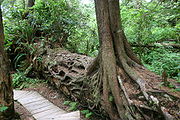
Nurse log
Encyclopedia
A nurse log is a fallen tree
which, as it decays, provides ecological facilitation
to seedlings. Broader definitions include providing shade or support to other plants. Some of the advantages a nurse log offers to a seedling (as enumerated by Daniel Mathews) are: water
, moss
thickness, leaf litter, mycorrhizae, disease protection, nutrients, and sunlight
. Recent research http://www.nature.com/nature/journal/vnfv/ncurrent/full/nature09273.html into soil pathogens suggests that in some forest communities, pathogens hostile to a particular tree species appear to gather in the vicinity of that species, and to a degree inhibit seedling growth. Nurse logs may therefore provide some measure of protection from these pathogens, thus promoting greater seedling survivorship.
in fallen trees, resulting in the formation of niches of increasing size, which tend to fill with forest litter such as soil from spring floods, needles, moss
, mushrooms and other flora. Mosses also can cover the outside of a log, hastening its decay and supporting other species as rooting media and by retaining water. Small animals such as various squirrel
s often perch or roost on nurse logs, adding to the litter by food debris and scat. The decay of this detritus contributes to the formation of a rich humus that provides a seedbed and adequate conditions for germination.
 Nurse logs often provide a seedbed to conifers in a temperate rain forest
Nurse logs often provide a seedbed to conifers in a temperate rain forest
ecosystem.
Tree
A tree is a perennial woody plant. It is most often defined as a woody plant that has many secondary branches supported clear of the ground on a single main stem or trunk with clear apical dominance. A minimum height specification at maturity is cited by some authors, varying from 3 m to...
which, as it decays, provides ecological facilitation
Ecological facilitation
Facilitation describes species interactions that benefit at least one of the participants and cause harm to neither. Facilitations can be categorized as mutualisms, in which both species benefit, or commensalisms, in which one species benefits and the other is unaffected...
to seedlings. Broader definitions include providing shade or support to other plants. Some of the advantages a nurse log offers to a seedling (as enumerated by Daniel Mathews) are: water
Water
Water is a chemical substance with the chemical formula H2O. A water molecule contains one oxygen and two hydrogen atoms connected by covalent bonds. Water is a liquid at ambient conditions, but it often co-exists on Earth with its solid state, ice, and gaseous state . Water also exists in a...
, moss
Moss
Mosses are small, soft plants that are typically 1–10 cm tall, though some species are much larger. They commonly grow close together in clumps or mats in damp or shady locations. They do not have flowers or seeds, and their simple leaves cover the thin wiry stems...
thickness, leaf litter, mycorrhizae, disease protection, nutrients, and sunlight
Sunlight
Sunlight, in the broad sense, is the total frequency spectrum of electromagnetic radiation given off by the Sun. On Earth, sunlight is filtered through the Earth's atmosphere, and solar radiation is obvious as daylight when the Sun is above the horizon.When the direct solar radiation is not blocked...
. Recent research http://www.nature.com/nature/journal/vnfv/ncurrent/full/nature09273.html into soil pathogens suggests that in some forest communities, pathogens hostile to a particular tree species appear to gather in the vicinity of that species, and to a degree inhibit seedling growth. Nurse logs may therefore provide some measure of protection from these pathogens, thus promoting greater seedling survivorship.
Occurrence
Various mechanical and biological processes contribute to the breakdown of ligninLignin
Lignin or lignen is a complex chemical compound most commonly derived from wood, and an integral part of the secondary cell walls of plants and some algae. The term was introduced in 1819 by de Candolle and is derived from the Latin word lignum, meaning wood...
in fallen trees, resulting in the formation of niches of increasing size, which tend to fill with forest litter such as soil from spring floods, needles, moss
Moss
Mosses are small, soft plants that are typically 1–10 cm tall, though some species are much larger. They commonly grow close together in clumps or mats in damp or shady locations. They do not have flowers or seeds, and their simple leaves cover the thin wiry stems...
, mushrooms and other flora. Mosses also can cover the outside of a log, hastening its decay and supporting other species as rooting media and by retaining water. Small animals such as various squirrel
Squirrel
Squirrels belong to a large family of small or medium-sized rodents called the Sciuridae. The family includes tree squirrels, ground squirrels, chipmunks, marmots , flying squirrels, and prairie dogs. Squirrels are indigenous to the Americas, Eurasia, and Africa and have been introduced to Australia...
s often perch or roost on nurse logs, adding to the litter by food debris and scat. The decay of this detritus contributes to the formation of a rich humus that provides a seedbed and adequate conditions for germination.

Temperate rain forest
Temperate rainforests are coniferous or broadleaf forests that occur in the temperate zone and receive high rainfall.-Definition:For temperate rain forests of North America, Alaback's definition is widely recognized:-Global distribution:...
ecosystem.
Books
- Montagnini, Florencia, and Benedict, Carl F. Jordan (2005). Tropical Forest Ecology: The Basis for Conservation and Management (1st ed.). Berlin: Springer. ISBN 3-540-23797-6.
- Noss, Reed F. (Ed). The Redwood Forest: History, Ecology, and Conservation of the Coast Redwoods (1999). San Francisco: Island Press. ISBN 1-55963-726-9
- Mathews, Daniel (1999). Cascade-Olympic Natural History (2nd ed.). Portland, Oregon : Raven Editions. ISBN 0-9620782-1-2
External links
- Mangan, Scott A., et al. "Negative plant–soil feedback predicts tree-species relative abundance in a tropical forest", NatureNatureNature, in the broadest sense, is equivalent to the natural world, physical world, or material world. "Nature" refers to the phenomena of the physical world, and also to life in general...
, New York, 2010-June-25. Retrieved on 2010-June-25

